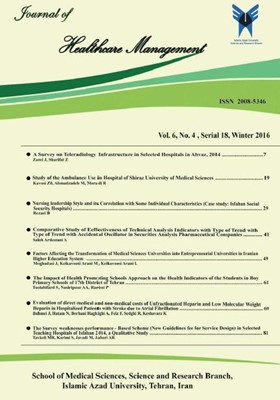-
-
List of Articles
-
Open Access Article
1 - A Survey on Teleradiology Infrastructure in Selected Hospitals in Ahvaz, 2014
Javad Zarei Zahra Sharifat -
Open Access Article
2 - Study of the Ambulance Use in Hospital of Shiraz University of Medical Sciences
Zahra Kavosi Mahdieh sadat Ahmadzadeh Reza Moradi -
Open Access Article
3 - Nursing leadership Style and its Correlation with Some Individual Characteristics (Case study: Isfahan Social Security Hospitals)
Behrooz Rezaei -
Open Access Article
4 - Comparative Study of Eeffectiveness of Technical Analysis Indicators with Type of Trend with Accidental Oscillator in Securities Analysis Pharmaceutical Companies
Abass Saleh Ardestani -
Open Access Article
5 - Factors Affecting the Transformation of Medical Sciences Universities into Entrepreneurial Universities in Iranian Higher Education System
Javad Moghaddasi Masuome Keikavoosi Arani Leila Keikavoosi Arani -
Open Access Article
6 - The Impact of Health Promoting Schools Approach on the Health Indicators of the Students in Boy Primary Schools of 17th District of Tehran
somayeh toolabifard Amir Ashkan Nasiripour pouran Raiisi -
Open Access Article
7 - Evaluation of direct medical and non-medical costs of Unfractionated Heparin and Low Molecular Weight Heparin in Hospitalized Patients with Stroke due to Atrial Fibrillation
Jamshid Bahmei nahid Hatam afshin Borhani Haghighi farnia Feiz reihane Sedghi Khosro Keshavarz -
Open Access Article
8 - The Survey weaknesses performance - Based Scheme (New Guidelines fee for Service Design) in Selected Teaching Hospitals of Isfahan 2014, a Qualitative Study
mohamad reza Tavkoli saeid Karimi marziye Javadi Ali reza Jabari
-
The rights to this website are owned by the Raimag Press Management System.
Copyright © 2021-2025







